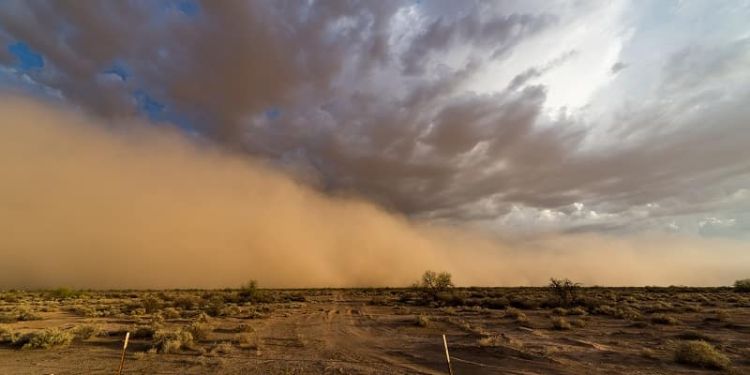Dust Storms

Mineral dust emitted from deserts is one of the most important natural contributors to fine particles in the atmosphere. Dust storms form when sufficiently high winds occur over soils that contain grains small enough to remain in the atmosphere after having been lifted from the surface. These particles are typically only a few micrometers (a thousandth of a mm) in diameter.
Atmospheric dust is currently a very active research topic due to its effects on climate and weather brought about by processes such as the reflection and absorption of sunlight by dust layers, the formation of ice on dust particles in clouds and the fertilization of phytoplankton and rainforests through iron contained in dust. The meteorological systems that generate winds strong enough to lift dust cover spatial scales from continental to a few meters. They include (A) low-pressure systems and cold fronts (similar to the ones affecting the UK), (B) so-called haboob dust storms that are generated by the outflow of air cooled by the evaporation of rain from thunderstorms and (C) small-scale rotating dust devils that are dynamically similar to tornadoes.
In order to fully understand the effect of dust on weather and climate, numerical models have been developed that try to simulate the dust cycle from emission over transport to deposition by gravitational settling or by wash-out in clouds. Given the remote location of most dust sources there is only limited observational data available to test the reliability of such models. The highly non-linear dependence of dust emission on near surface wind speed makes it extremely sensitive to the horizontal and vertical resolution of the model as well as to the representation of the planetary boundary layer and deep moist convection.
The Dust Storms group, led by Professor John Marsham in collaboration with Professor Peter Knippertz at KIT, studies meteorological processes involved in the generation of high winds in desert regions, particularly in the Sahara and Sahel: cyclonic storms, low-level jets, convective dust storms (haboobs) and dust devils.
Dust is the most abundant aerosol by mass and is involved in many processes in the Earth system such as radiative transfer, cloud microphysics and fertilisation of ecosystems. Dust also has an important impact on human health, agriculture, road traffic and aviation.
We are primarily involved in data analysis (ground-based, aircraft, satellite) and modelling studies, using a wide range of models from small-scale Large Eddy to global climate models. We collaborate extensively with other groups both nationally and internationally, including the UK Met Office and the Institute for Tropospheric Research in Leipzig, Germany.
Contact us
If you would like to discuss an area of research in more detail please contact the Research Group Lead: Professor John Marsham

